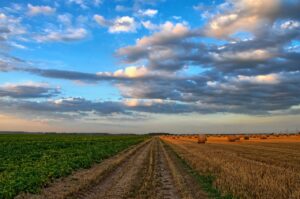How Sustainable Advances in Agriculture Shape Communities
 All the food consumed and many of the materials used worldwide every day come from farms across the country. If it weren’t for dedicated farmers and agriculture workers, the health, wellness, and survival of the public would be at risk.
All the food consumed and many of the materials used worldwide every day come from farms across the country. If it weren’t for dedicated farmers and agriculture workers, the health, wellness, and survival of the public would be at risk.
But as essential as agriculture is, there are a whole lot of resources used to cultivate soil, grow crops, raise livestock, and maintain fisheries and forestry. Doing this has negatively impacted the planet’s health. Hence, sustainability has become a hot topic in agriculture.
Eco-friendly advancements in agriculture aren’t just good for reviving environmental health, but they positively impact communities too. First, let’s dig into the details of sustainable advances making the most noise in the agriculture industry.
Smart Farming
When people think about farming, they think about manual labor. Looking after the livestock, harvesting crops, irrigating soil, landscaping — all of it’s been done primarily by hand until now.
As admirable as this is, accidents and errors are all too common with manual labor. It’s incredibly time-consuming as well, affecting any farm’s efficiency. Thankfully, smart farming systems are transforming agriculture. Smart farming is the use of modern technologies to manage agricultural production systems. These technologies can automate certain processes, making them less labor-intensive and more precise.
In addition, smart farming technologies collect massive sets of data you can use to make data-driven decisions about how to move farming forward. Smart farming systems include:
- Sensors;
- Data analytics;
- GPS technology;
- Cellular-connected drones;
- Robots equipped with cameras;
- Self-propelled tractors controlled through a mobile app.
This isn’t an exhaustive list by any means. Automation, analytics, and artificial intelligence find their way into farming processes in various ways.
Fleet Management Technology
You could put fleet management technology into the smart farming category. However, it deserves its own section for just how effective it has been in securing a more sustainable approach to agriculture.
The fleet of vehicles farmers use to maintain their operations is responsible for much of the fossil fuels produced in agriculture. The distance, how often they’re driven, and the gas that powers these vehicles are the main culprits.
Fleet management technology helps agriculture workers reduce their fossil fuel contributions significantly. You can keep track of fuel use, mileage, routes, engine speed, upcoming maintenance, and safety risks with this technology.
Having access to real-time data about fleets supports farmers in using these vehicles efficiently, positively impacting production and environmental health.
Renewable Energy
According to the International Renewable Energy Agency (IRENA), “production and agriculture consume about 30% of the world’s energy production — primarily fossil fuels.” Who knew raising livestock and farming would require almost a third of the world’s energy?
The scary thing is that most of this energy isn’t renewable, meaning it won’t self-replenish what’s used. The majority of agricultural vehicles, in particular, rely on fossil fuels. And these fossil fuels release greenhouse gases that incite climate change.
Because of this, farmers are turning to renewable energy. You can’t deplete this resource. So, it’s much more environmentally friendly. Solar technologies, wind turbines, and biomass are just a few of the renewable energy technologies changing the agriculture game.
Green Building
Aside from how things are grown and managed on a farm, we must acknowledge how sustainability affects the buildings and structures that make agriculture possible.
Building materials, for example, can end up on either side of the eco-friendly spectrum. Glass, steel, and reinforced concrete are commonly used but hardly sustainable. On the other hand, bamboo, cork, and recycled materials are much more eco-friendly.
Because the way we build in agriculture impacts the environment too, sustainable construction methods are becoming more popular. Sustainable construction, also known as green building, involves using mainly renewable resources throughout every construction phase, reducing waste and the negative environmental impact.
Sustainable construction methods include:
- Relying on recycled or salvageable materials;
- Using renewable resources and materials;
- Ensuring natural habitats remain untouched;
- Using local resources to obtain materials;
- Using designs that are intentional about reducing energy consumption.
Implementing these methods results in lower lifecycle costs, less waste, and reduced rework of agricultural processes.
These Advances Shape the Future of Our Communities
As wonderful as these advances are for the agriculture sector, people aren’t talking enough about what they’re doing for surrounding communities.
Sustainable agriculture contributes to healthier cities, in general. Instead of depleting natural resources and taking away liveable land, sustainable agriculture supports both of these things. Farmers are more mindful of how they’re using natural resources. And by doing this, they’re making great use of the land.
Smart farming, in particular, streamlines production. Farmers that use it can get food out to stores and people much faster, improving access.
Green building impacts housing and commercial properties. Sustainable construction uses materials and processes that are more attractive to potential buyers that pride themselves on sustainability. In addition, the more houses built green, the more families that can experience the benefits of environmentally-friendliness.
Finally, using eco-friendly resources contributes to agriculture longevity. If we continue to farm without sustainability at the forefront, we won’t have much land or resources to support farming in the future. Sustainable advances help us maintain the integrity and durability of agriculture.
Final Thoughts
There’s no denying the environmental impact of agriculture. Sustainable advances can not only curb the negative effects on our planet’s health, but they can also improve and shape the future of our communities.


Sorry, the comment form is closed at this time.